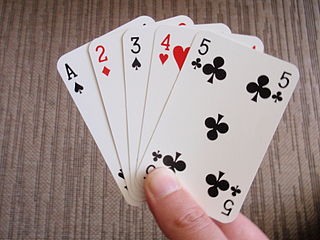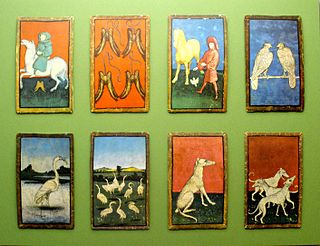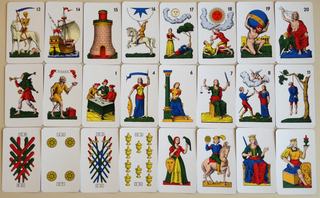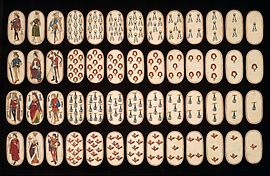
A playing card is a piece of specially prepared card stock, heavy paper, thin cardboard, plastic-coated paper, cotton-paper blend, or thin plastic that is marked with distinguishing motifs. Often the front (face) and back of each card has a finish to make handling easier. They are most commonly used for playing card games, and are also used in magic tricks, cardistry, card throwing, and card houses; cards may also be collected. Playing cards are typically palm-sized for convenient handling, and usually are sold together in a set as a deck of cards or pack of cards.

Tarot is a pack of playing cards, used from at least the mid-15th century in various parts of Europe to play card games such as Tarocchini. From their Italian roots, tarot-playing cards spread to most of Europe, evolving into a family of games that includes German Grosstarok and modern games such as French Tarot and Austrian Königrufen. In the late 18th century French occultists made elaborate, but unsubstantiated, claims about their history and meaning, leading to the emergence of custom decks for use in divination via tarot card reading and cartomancy. Thus, there are two distinct types of tarot packs in circulation: those used for card games and those used for divination. However, some older patterns, such as the Tarot de Marseille, originally intended for playing card games, are occasionally used for cartomancy.

Tapestry is a form of textile art, traditionally woven by hand on a loom. Normally it is used to create images rather than patterns. Tapestry is relatively fragile, and difficult to make, so most historical pieces are intended to hang vertically on a wall, or sometimes horizontally over a piece of furniture such as a table or bed. Some periods made smaller pieces, often long and narrow and used as borders for other textiles. Most weavers use a natural warp thread, such as wool, linen, or cotton. The weft threads are usually wool or cotton but may include silk, gold, silver, or other alternatives.

A necklace is an article of jewellery that is worn around the neck. Necklaces may have been one of the earliest types of adornment worn by humans. They often serve ceremonial, religious, magical, or funerary purposes and are also used as symbols of wealth and status, given that they are commonly made of precious metals and stones.

A Jack or Knave, in some games referred to as a Bower, in Tarot card games as a Valet, is a playing card which, in traditional French and English decks, pictures a man in the traditional or historic aristocratic or courtier dress, generally associated with Europe of the 16th or 17th century. The usual rank of a jack is between the ten and the queen.

In a deck of playing cards, the term face card (US) or court card, and sometimes royalty, is generally used to describe a card that depicts a person as opposed to the pip cards. In a standard 52-card pack of the English pattern, these cards are the King, Queen and Jack. The term picture card is also common, but that term sometimes includes the Aces.

Spanish-suited playing cards or Spanish-suited cards have four suits, and a deck is usually made up of 40 or 48 cards. It is categorized as a Latin-suited deck and has strong similarities with the Portuguese-suited deck, Italian-suited deck and some to the French deck. Spanish-suited cards are used in Spain, southern Italy, parts of France, Hispanic America, North Africa, and the Philippines.

Playing cards have been in Italy since the late 14th century. Until the mid 19th century, Italy was composed of many smaller independent states which led to the development of various regional patterns of playing cards; "Italian suited cards" normally only refer to cards originating from northeastern Italy around the former Republic of Venice, which are largely confined to northern Italy, parts of Switzerland, Dalmatia and southern Montenegro. Other parts of Italy traditionally use traditional local variants of Spanish suits, French suits or German suits.
Minchiate is an early 16th-century card game, originating in Florence, Italy. It is no longer widely played. Minchiate can also refer to the special deck of 97 playing cards used in the game. The deck is closely related to the tarot cards, but contains an expanded suit of trumps. The game was similar to but more complex than tarocchi. The minchiate represents a Florentine variant on the original game.

Flemish painting flourished from the early 15th century until the 17th century, gradually becoming distinct from the painting of the rest of the Low Countries, especially the modern Netherlands. In the early period, up to about 1520, the painting of the whole area is typically considered as a whole, as Early Netherlandish painting. This was dominated by the Flemish south, but painters from the north were also important. Dutch and Flemish Renaissance painting, of which Antwerp became the centre, covers the period up to about 1580 or later, by the end of which the north and south Netherlands had become politically separated. Flemish Baroque painting was especially important in the first half of the 17th century, dominated by Rubens.

Hofämterspiel, one of the earliest packs of playing cards on record preserved in its entirety with all 48 cards intact, is a major 15th-century medieval handmade deck commissioned by Ladislaus the Posthumous, King of Hungary and Bohemia and Duke of Austria from 1453 to 1457. It was found among the great collection of art treasures of Archduke Ferdinand II of Tirol in castle Ambras, Austria, together with another called Ambraser Hofjagdspiel. Their heraldic suits represent, to an extent, "the political and dynastic relationships in Central Europe in middle of the 15th century" and are "of a quality unsurpassed at this early date."

Anthonie Palamedesz., also Antonie Palamedesz, birth name Antonius Stevens, was a Dutch portrait and genre painter. He is in particular known for his merry company paintings depicting elegant figures engaged in play, music and conversation as well as guardroom scenes showing soldiers in guardrooms. Like many Dutch painters of his time, he painted portraits and still lifes, including vanitas still lifes. He further painted the staffage in a few views of the interior of churches. He played a major role in the development of genre painting in Delft in the mid 17th century.

The Ambraser Hofjagdspiel is a pack of cards painted around 1440–1445 and attributed to the engraver Konrad Witz from Basel, Switzerland. It originally consisted of fifty-six cards from which only 54 survive, all distributed in four suits, falcons, lures, hounds and herons, symbols related to hunting. Each suit contained ten pip cards with the 10s being represented by a banner like many old German playing cards and modern Swiss playing cards. There are four face cards per suit: the Unter, Ober, Queen, and King. It was found in a collection at the Ambras Castle, in Innsbruck, Austria, in the 16th century, and now figures as a precious item in the collection of cards of the Kunsthistorisches Museum in Vienna.

German-suited playing cards are a very common style of traditional playing card used in many parts of Central Europe characterised by 32- or 36-card packs with the suits of Acorns, Leaves, Hearts and Bells. The German suit system is one of the oldest, becoming standard around 1450 and, a few decades later, influencing the design of the now international French suit system of Clubs, Spades, Hearts and Diamonds. Today German-suited playing cards are common in south and east Germany, Austria, German-speaking Switzerland, Liechtenstein, north Italy, Hungary, Czech Republic, Slovakia, Slovenia, Croatia, Bosnia, northern Serbia, southern Poland and central and western Romania.

A supportasse or underpropper is a stiffened support for a ruff or collar. Essential items of courtly fashion in the late 16th and early 17th centuries, supportasses are sometimes called piccadills, whisks,rebatos, or portefraise, terms used at different times for both the supporters and the various lace or linen collar styles to which they were attached.
I pray you, sir, what say you to these great ruffs, which are borne up with supporters and rebatoes, as it were with post and rail?

The Tarocco Siciliano is a tarot deck found in Sicily and is used to play Sicilian tarocchi. It is one of the three traditional Latin-suited tarot decks still used for games in Italy, the others being the more prevalent Tarocco Piemontese and the Tarocco Bolognese. The deck was heavily influenced by the Tarocco Bolognese and the Minchiate. It is also the only surviving tarot deck to use the Portuguese variation of the Latin suits of cups, coins, swords, and clubs which died out in the late 19th and early 20th centuries.

The Tarocco Bolognese is a tarot deck found in Bologna and is used to play tarocchini. It is a 62 card Italian suited deck which influenced the development of the Tarocco Siciliano and the obsolete Minchiate deck.

French-suited playing cards or French-suited cards are cards that use the French suits of trèfles, carreaux, cœurs, and piques. Each suit contains three or four face/court cards. In a standard 52-card deck these are the valet, the dame, and the roi (king). In addition, in Tarot packs, there is a cavalier (cavalier) ranking between the queen and the jack. Aside from these aspects, decks can include a wide variety of regional and national patterns, which often have different deck sizes. In comparison to Spanish, Italian, German, and Swiss playing cards, French cards are the most widespread due to the geopolitical, commercial, and cultural influence of France, the United Kingdom, and the United States in the 19th and 20th centuries. Other reasons for their popularity were the simplicity of the suit insignia, which simplifies mass production, and the popularity of whist and contract bridge. The English pattern of French-suited cards is so widespread that it is also known as the International or Anglo-American pattern.

The Sola Busca tarot is the earliest completely extant example of a 78-card tarot deck. It is also the earliest tarot deck in which all the plain suit cards are illustrated and it is also the earliest tarot deck in which the trump card illustrations deviate from the classic tarot iconography. Unlike the earlier Visconti-Sforza tarot decks, the cards of the Sola Busca are numbered. The trump cards have Roman numerals while the pips of the plain suits have Arabic numerals.The deck was created by an unknown artist and engraved onto metal in the late 15th century. A single complete hand-painted deck is known to exist, along with 35 uncolored cards held by various museums. The deck is notable not only for its age, but also for the quality of its artwork, which is characterized by expressive figures engraved with precise contours and shading. Various theories have been suggested about who created the deck, but its authorship remains uncertain.

The Stuttgart pack or Stuttgart Cards is one of the most valuable collections of the Landesmuseum Württemberg. It is a hunting-themed deck of playing cards painted on gilded pasteboard dating to around 1430. They are thus among the earliest surviving packs of playing cards.
























